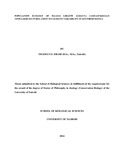| dc.description.abstract | Wildlife populations and their habitats are facing serious threats from global changes in climate
and human development activities. Large herbivores with slow reproductive rates, bulk food
requirements, wide foraging ranges and high potential value are highly vulnerable to those
changes. Their responses to environmental pressures and human-induced landscape changes are
however, not well understood. The purpose of this study was to generate essential data and
information to support sustainable conservation and management of Maasai giraffes in the
changing landscape of southern Kenya.
Giraffe population characteristics were investigated through observations and counts of giraffes along belt
transects established in Nairobi, Amboseli and Tsavo West National Parks. The primary data were used to
analyze giraffe population structure and changes in its spatial and temporal distribution.
Primary data were collected on mean annual rainfall amounts and temperature ranges. Similarly,
secondary data on the above variables for the past 30 years were reviewed to determine the long
term rainfall and temperature variability in the three study sites. Data was collected on the
distribution of water sources in the three study sites. Data was also collected on giraffes‟ habitat use and
occupancy and the number of plant species eaten by giraffes during the wet and dry seasons.
Giraffe home range sizes were determined using both 95% and 50% Minimum Convex Polygon
(MCP) and Kernel Density (KD) methods. Data on human impacts on giraffe and its habitats was
collected and assessed to determine the magnitude of the impacts.
One-way ANOVA was used to test if there were significant differences in the mean number of
giraffes of different age-classes in the different habitats. When tests were performed on groups of
adult males, there was no significant difference in the mean number of giraffes in this age-class
(F 1, 4 = 7.71, p > 0.05). When a similar test was performed on groups of adult females, there was
still no significant difference in the mean number of giraffes in this age-class (F 1, 4 = 7.71, p >
0.05). However, a test performed on groups of sub-adult males, showed a significant difference
in this age-class (F 3, 18 = 3.16, p < 0.05). Independent samples test using Levene‟s F test for equality
of variances showed no significant difference in the mean number of giraffes during the wet and dry
seasons in the three study sites (F 1, 4 = 12.22, p > 0.05). Chi-square tests showed no significant
the wet and dry season giraffe home range sizes in the three study sites (U 0.05, 5, 5 = 2, p > 0.05).
This study concluded that the number of giraffes had increased over time inside protected areas as
compared to that outside protected areas. The study recommended that a concise study be carried
out on how Maasai giraffe population trends and distribution are related to the current land use
changes and infrastructure development in Southern Kenya. | en_US |

